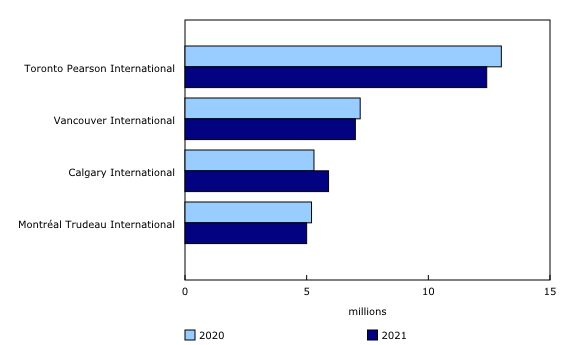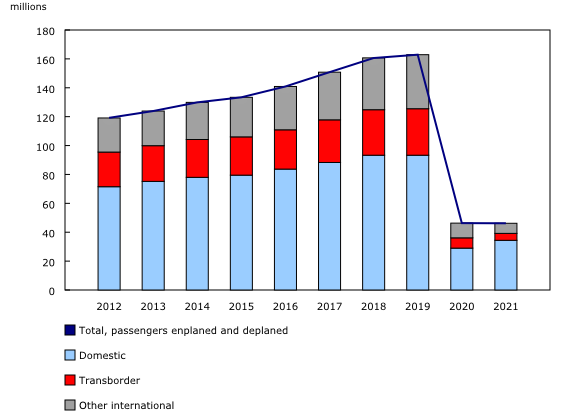Airport activity, 2021
Released: 2022-12-08
46.2 million
2021
-0.4% 
(year-over-year change)
Highlights
The onset of the COVID-19 pandemic in 2020 brought an abrupt end to 10 consecutive annual increases in air passenger volumes. In 2021, the pandemic continued to put a damper on Canadian aviation. The total number of passengers enplaned and deplaned at Canadian airports was 46.2 million in 2021, similar to 2020 (-0.4%) but still 71.7% below the 2019 pre-pandemic level.
These totals mask sub-annual differences between 2020 and 2021, the two years impacted by the pandemic. As reported earlier based on data from airlines, while the majority (roughly 70%) of passengers in 2020 were flown in the first three months of the year, more than four in five passengers were carried in the second half of the year in 2021.
Passenger traffic decreased in 2021 at three of Canada's four largest airports. Toronto Pearson International Airport, Vancouver International Airport and Montréal Trudeau International Airport each saw decreases in passenger traffic of 4.8%, 2.7% and 3.9% respectively. This largely reflected the lag in international passenger volumes, compared with domestic passengers. Calgary International Airport was the exception, with traffic increasing by 11.0%.
Restrictions inhibit international recovery
With an uptake in vaccination rates during 2021, some restrictions were relaxed. For example, mandatory testing for fully vaccinated Canadian citizens arriving in Canada ceased in July, which helped domestic traffic start recovering sooner. In fact, the number of domestic passengers increased by 18.3% (+5.3 million) in 2021 from the previous year.
However, this uptick in domestic traffic was partly offset by further declines in international travel, as some travel restrictions lingered. Beginning in early 2021, tighter border restrictions were introduced to combat a new variant of the virus. These included a ban on discretionary travel to Canada by non-residents, a negative PCR test prior to boarding, testing upon arrival to Canada and a mandatory 14-day quarantine.
Some recovery in international travel resumed mid-year, as higher vaccination rates allowed the federal government to ease border restrictions for non-residents, while provinces relaxed remaining interprovincial travel restrictions. Nevertheless, transborder traffic (Canada–United States) and international traffic remained farther below 2020 levels, with the former down 31.7% (2.2 million passengers) and overseas traffic down 31.9% (3.3 million passengers).
Canada's busiest airports
In 2021, the four busiest airports accounted for just under two-thirds (65.5%) of all passenger traffic in Canada including over half (54.7%) of all domestic traffic and much larger shares of transborder (95.5%) and other international traffic (98.5%). For most of the year, commercial flights originating from any international location were directed to land at one of these four Canadian airports.
Passenger traffic at Canada's busiest airport, Toronto's Pearson International Airport, declined by 4.8%, going from 13.0 million passengers in 2020 to 12.4 million passengers in 2021. The overall traffic decrease in 2021 was attributed to the international and transborder sectors, which fell 24.2% and 25.3% respectively. Continued intermittent travel restrictions on non-domestic travel throughout 2021 contributed to the decline.
This overall decline at Pearson was somewhat offset by the domestic sector, recording an increase of 24.4%. Domestic traffic benefitted from the easing of some government travel restrictions late in 2021.
Vancouver International Airport enplaned and deplaned 7.0 million passengers in 2021, down 2.7% from 2020. This drop was entirely caused by international traffic, with overseas traffic falling 39.1% and transborder down 29.2%. As with Toronto Pearson International, the decrease at Vancouver International was offset by a 22.0% increase in domestic traffic.
In a challenging year for the aviation industry, Calgary International Airport maintained its position as Canada's third-busiest airport. Of the four busiest airports in the country, Calgary International Airport was the only airport to post a year-over-year increase in passenger traffic. Overall traffic was up 11.0% in 2021, with 5.9 million passengers enplaning and deplaning at the airport.
This increase was caused by a rebound in domestic traffic (up 23.9% in 2021). However, international traffic continued to contract, with the other international sector falling 30.8% and transborder traffic down 27.0%.
Rounding out the top four, Montréal Trudeau International Airport saw 5.0 million passengers enplaned and deplaned, down from 5.2 million in 2020. With international travel restrictions in place, transborder traffic declined by 18.4% and international traffic fell 17.8%. Conversely, domestic traffic increased at a slower rate than at the other top airports (up 19.9% in 2021).
Cargo, the silver lining
The year 2021 continued a shift in aviation activity, from moving passengers to moving cargo. With passenger traffic still scarce, this shift helped keep aircraft in use. Early in the pandemic, some airlines began to operate cargo-only flights and made aircraft modifications to do so. The increase in cargo-only flights helped boost cargo traffic in 2021, with tonnes loaded and unloaded at Canadian airports up 7.9% after a decline of 13.8% in 2020.
The amount of domestic cargo transported by air increased by 7.1% from 2020 to 655 000 tonnes in 2021. Transborder cargo grew modestly by 3.7% (254 000 tonnes), while other international cargo grew by 12.3% (371 000 tonnes).
During the second year of the pandemic, cargo operators continued to benefit from transporting essential goods and from online shopping. By the end of 2021, quarterly goods revenue earned by the airline industry had doubled from 2019 pre-pandemic levels.
Looking ahead
While 2021 brought the Canadian aviation industry hope of recovery with an increase in domestic traffic and cargo volumes, all measures of passenger and cargo activity continued to be far below their pre-pandemic 2019 levels.
With vaccine rollouts, the re-opening of provincial economies and the subsequent easing of travel restrictions throughout 2021, airport activity crept closer to pre-pandemic levels each month. After a pause in January 2022 because of Omicron, demand for air travel—domestic and international—has increased steadily in each month of 2022.
The increase during 2022 culminated with a surge in travel demand into the busy summer travel season. The higher volume of passengers, coupled with ongoing industry labour shortages, resulted in long delays and cancellations at some airports, and several carriers trimmed flight schedules to improve operations.
Note to readers
This survey collects data on passengers enplaned and deplaned, and cargo loaded and unloaded at Canadian airports.
With each release, data for the previous reference year may be revised.
Cargo data: It is important to note that the air cargo data presented do not represent the total cargo loaded and unloaded in Canada. Comprehensive cargo data are not collected for the following reasons: (1) the regional and local scheduled carriers do not file cargo data for the Airport Activity Survey, and (2) the major charter survey does not collect data on domestic courier cargo or domestic entity cargo flights.
Products
Additional analytical information is now available in "Airport Activity: Air Carrier Traffic at Canadian Airports, 2021," as part of the service bulletin Aviation (51-004-X).
Contact information
For more information, or to enquire about the concepts, methods or data quality of this release, contact us (toll-free 1-800-263-1136; 514-283-8300; infostats@statcan.gc.ca) or Media Relations (statcan.mediahotline-ligneinfomedias.statcan@statcan.gc.ca).
- Date modified:


